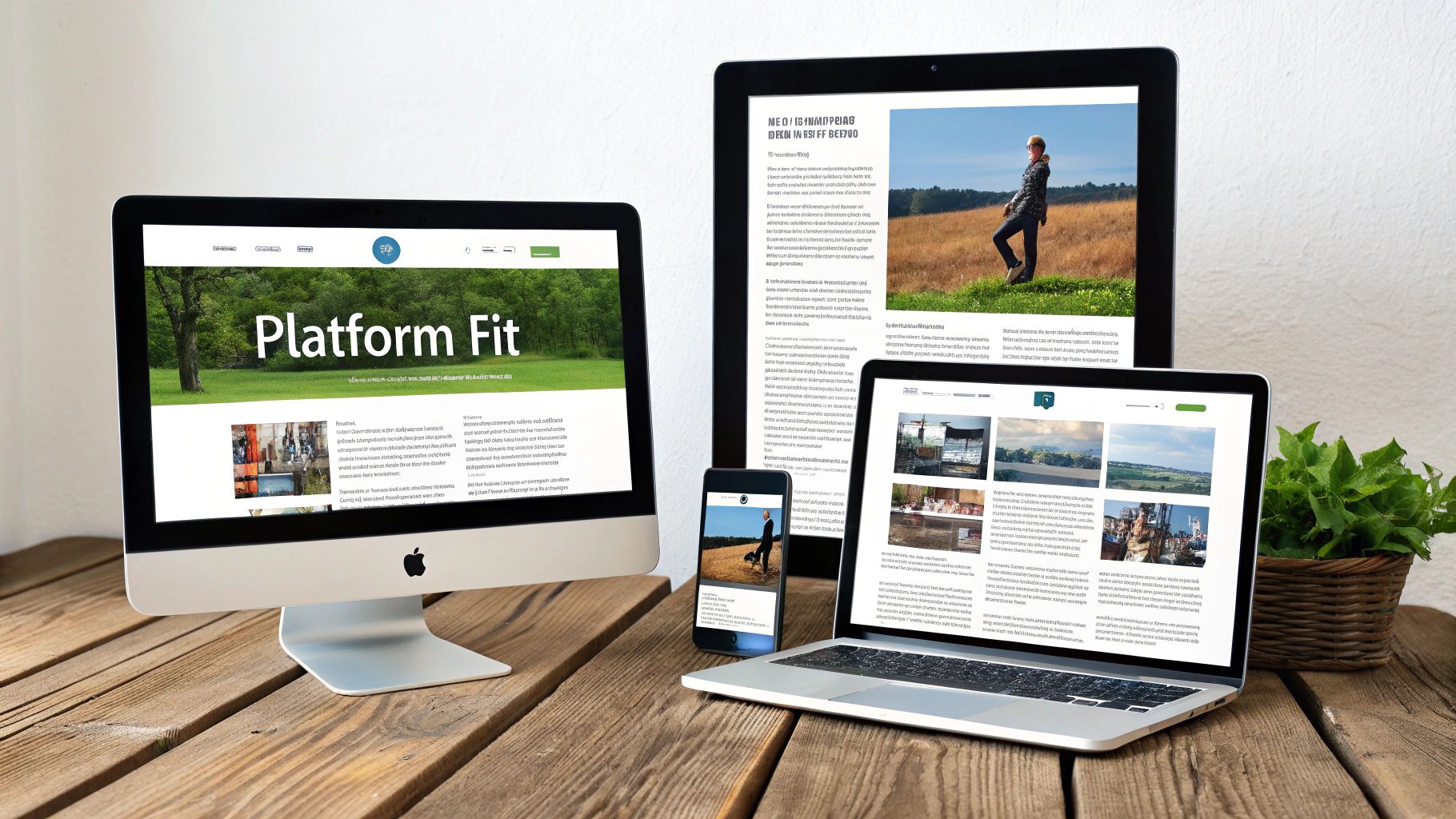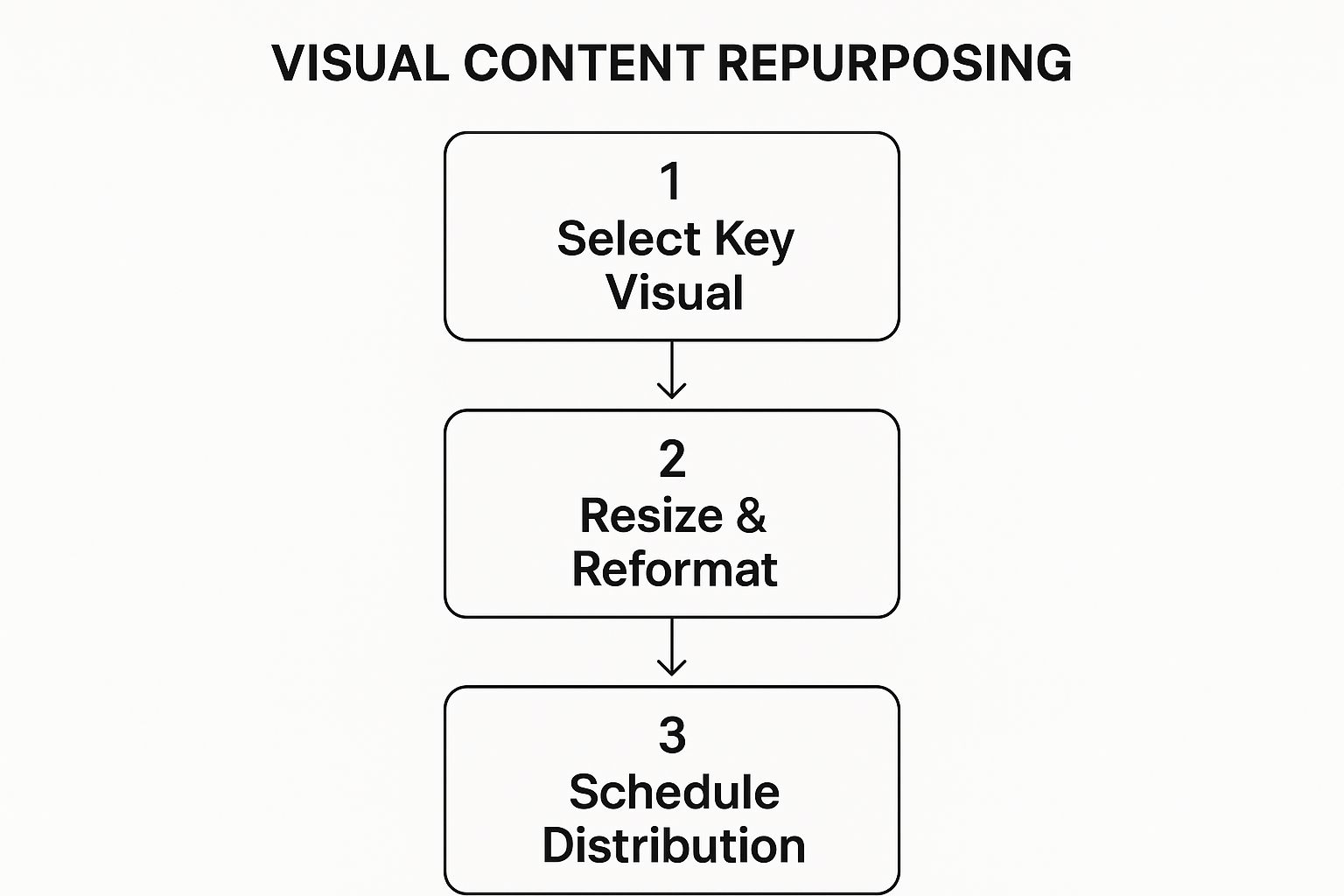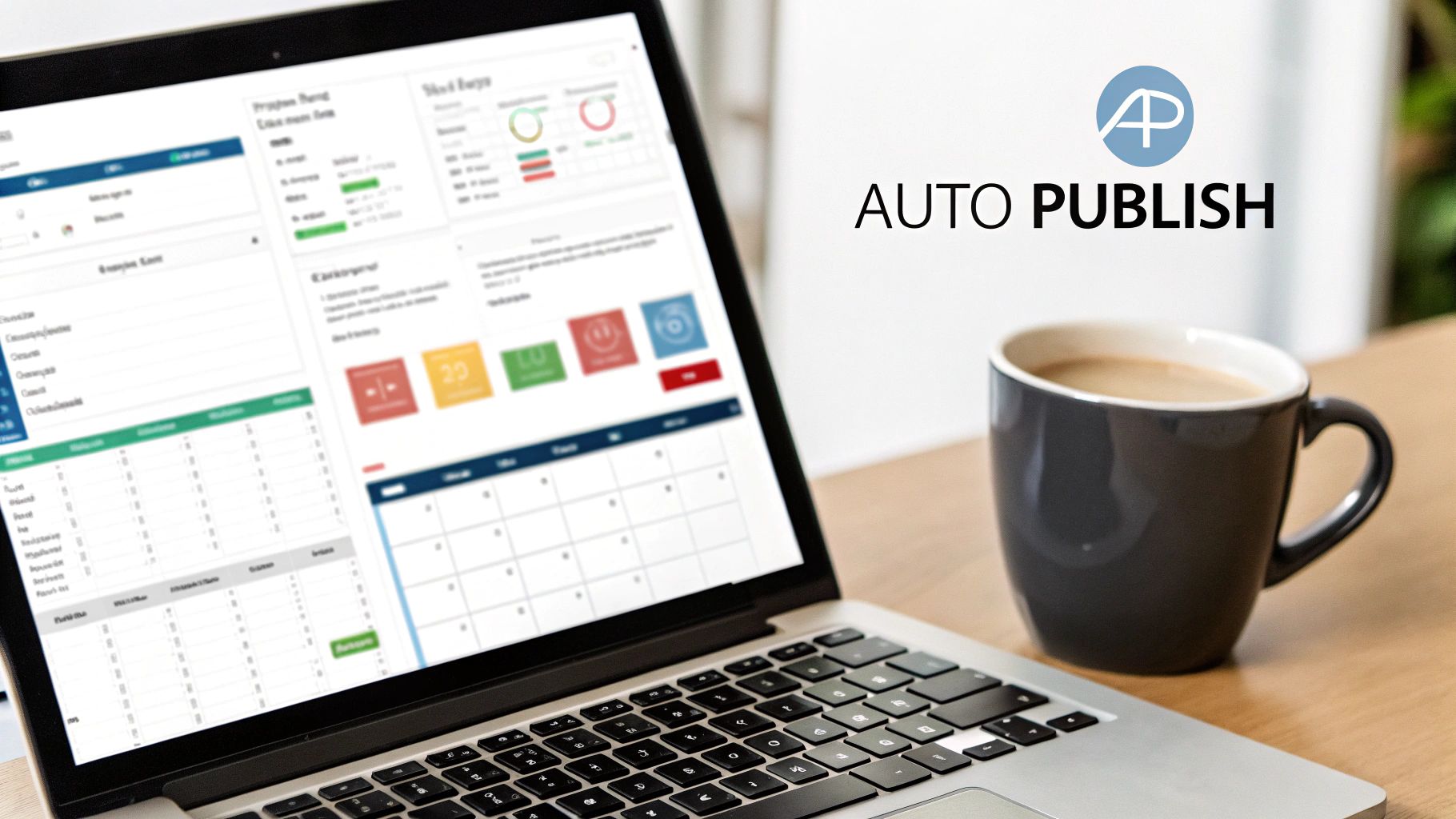Why Smart Marketers Are Obsessed With Content Repurposing
Creating engaging social media content day in and day out can be a real challenge. It's time-consuming, demands resources, and can quickly lead to burnout. That's why savvy marketers are increasingly adopting content repurposing as a key strategy. Instead of constantly starting from scratch, they're finding ways to make their existing content work harder across different platforms.
This allows them to maximize their reach and impact without needing to constantly generate fresh material. This shift in mindset—from creating more content to creating smarter content—is reshaping how we approach social media marketing.
Stretching Your Content’s Reach and Impact
Think of your top-performing blog post as a versatile tool. With content repurposing, you can transform that single piece of content into a variety of formats perfectly tailored for different social media platforms. For example, a data-heavy blog post could become an infographic for Instagram, a series of insightful tweets for Twitter, or even a short, engaging video for TikTok.
This multifaceted approach significantly expands your content’s reach and allows you to connect with different audience segments who prefer consuming information in various ways. Repurposing also reinforces your key messages across multiple touchpoints, increasing brand recognition and strengthening your authority in your field.
The Power of Efficiency and Cost Savings
Repurposing content isn’t just about working smarter; it’s also about working more efficiently. By leveraging existing assets, you can significantly reduce the time and resources needed for content creation. This is particularly important for businesses with limited budgets and smaller teams.
Instead of spending hours crafting unique content for each platform, you can focus on adapting and optimizing existing material. This frees up valuable time for other important marketing activities. This efficient approach translates to substantial cost savings and maximizes your return on investment. As of 2025, repurposing content has become a dominant strategy in social media marketing, with 82% of marketers actively repurposing content across various channels according to HubSpot data cited by Meltwater. This practice is favored because it accelerates content creation and expands reach by adapting existing assets to different platforms and audience preferences. Find more detailed statistics here: Discover more insights about social media statistics
From One Piece of Content to a Multi-Platform Powerhouse
Imagine creating a comprehensive white paper full of valuable insights. Through strategic repurposing, that single asset can fuel your social media presence for weeks or even months. You could extract key statistics and create visually appealing graphics for Instagram, share bite-sized takeaways as LinkedIn posts, host a live Q&A on Twitter based on the white paper’s findings, or even turn sections into a series of short, informative videos for YouTube.
This “one-to-many” approach allows you to extract maximum value from your content, ensuring it reaches the widest possible audience and drives maximum engagement across various social media platforms.
Building a Sustainable Content Strategy
Repurposing isn't a quick fix; it’s a long-term strategy for building a sustainable and effective social media presence. By systematically transforming and adapting existing content, you create a consistent flow of engaging material without overworking your team.
This promotes a more balanced and less stressful approach to content creation, preventing burnout and ensuring your social media efforts remain consistent and effective over time. This, in turn, strengthens your brand’s online presence and cultivates a loyal and engaged audience across all your social media channels.
The Hidden Goldmine In Today's Social Media Landscape

Social media offers an incredible opportunity for brands to connect with their target audience. The sheer number of people using these platforms presents a vast, largely untapped potential. Most brands, however, aren't strategically repurposing content, missing out on valuable engagement opportunities. Consider these content repurposing strategies to better understand the landscape.
Effective content repurposing isn't simply copying and pasting the same message across all platforms. It's about understanding how each platform's audience interacts with content and tailoring your approach accordingly. This means your content has multiple chances to resonate with different audiences.
For example, think about how people consume content on Instagram versus LinkedIn. Instagram users often prefer visually-driven content like images and short videos. LinkedIn users, on the other hand, tend to engage more with long-form articles and professional discussions. This highlights the importance of adapting content to suit each specific platform.
The proliferation of social media platforms creates a diverse ecosystem for content distribution. In early 2025, there were approximately 5.24 billion active social media user identities globally, a 4.1% increase from the previous year. Explore this topic further. This massive and growing audience allows brands to connect with different segments of their target market.
Identifying Opportunities for Growth
Smart repurposing goes beyond vanity metrics like likes and followers. It involves analyzing engagement patterns on each platform to understand what truly resonates with your audience. Ask yourself which types of content generate the most comments or shares. Are certain topics consistently sparking discussions? These insights can reveal valuable opportunities for growth.
Aligning Platforms With Your Goals
Each social media platform has unique strengths and weaknesses. Your repurposing strategy should align with your overall marketing objectives. For example, if your goal is to drive website traffic, platforms like Facebook and Twitter, which allow for direct links, might be more effective than Instagram, which has more limitations on link sharing. Understanding these nuances will help you maximize your impact.
Maximizing Impact Through Strategic Repurposing
Content repurposing is about maximizing the reach and impact of your content. By analyzing audience behavior, aligning platforms with your goals, and identifying key engagement patterns, you can transform your existing content into a powerful engine for social media success. This strategic approach is the key to unlocking the true potential within the social media landscape, allowing you to connect with a broader audience and achieve your business objectives.
Finding Your Content Gold: The Strategic Audit Approach

Before sharing your content across social media, it's essential to understand what already resonates with your audience. A strategic content audit can unearth hidden gems and uncover untapped potential. This process helps identify top-performing content, understand audience preferences, and pinpoint evergreen content for refreshing and repurposing.
Identifying Your Top Performers
The first step is identifying your best-performing content. Which blog posts, videos, or social media updates generated the most engagement? Which pieces drove the most website traffic? These high-performers are ideal for repurposing. This allows you to build on proven success and adapt it for different platforms. Check out this guide on How to master content repurposing strategies.
A popular blog post, for example, could become a series of engaging social media posts. Each post can highlight a key takeaway or statistic. Similarly, a webinar recording can be broken down into shorter video clips optimized for platforms like Instagram, TikTok, or YouTube Shorts.
Understanding Audience Resonance
Beyond identifying top performers, understanding why certain content resonates is crucial. What topics or formats consistently engage your audience? Analyzing engagement patterns reveals valuable insights into audience preferences. This allows you to tailor your repurposing efforts for maximum impact.
If your audience engages with visual content, prioritize repurposing written content into infographics or short videos. Consider visually appealing quote cards as well. If your audience prefers long-form content, consider transforming blog posts into LinkedIn articles or expanding podcast episodes into in-depth social media posts.
Spotting Evergreen Content Opportunities
Evergreen content remains relevant and valuable over time. Identifying this content within your existing library is crucial. It provides a foundation for long-term repurposing.
Identifying this high-performing and evergreen content is a crucial first step. Tools such as Circleboom provide marketers with analytics to pinpoint high-engagement posts, like top tweets. These can then be creatively transformed for use on other platforms. Learn more about content repurposing in 2025.
A guide on social media best practices, for instance, can be continually updated and repurposed as new trends emerge. Case studies showcasing successful client projects can be repurposed into various formats. Highlighting different aspects of each project’s success can be particularly effective. You might also be interested in: How to master content repurposing strategies. A strategic audit sets the stage for effective content repurposing, maximizing the reach and impact of your valuable content.
Platform Mastery: Adapting Content That Actually Converts
Repurposing content isn't about copying and pasting. It's about strategically transforming a single piece of content to resonate with each platform's unique audience. This means understanding each platform's algorithm, optimal posting formats, and user expectations.
To illustrate how to effectively adapt content across various platforms, let's look at a practical guide:
To illustrate how to effectively adapt content across various platforms, the table below provides a practical guide. It demonstrates how a single piece of content, in this case a long-form blog post, can be tailored for different social media channels, each with its own unique style and audience expectations.
| Original Content | TikTok | YouTube | |||
|---|---|---|---|---|---|
| Long-form blog post on social media marketing | Carousel post highlighting key takeaways, visually appealing graphics, and a call to action to read the full blog post. | Short summary of the blog post with a focus on professional insights and a link to the full article. Encourage discussion in the comments. | Series of short, engaging videos focusing on individual tips or statistics from the blog post. Use trending sounds and hashtags. | Thread summarizing the main points of the blog post. Include relevant hashtags and a link to the full article. | Short video summarizing the blog post’s key takeaways. Include visuals and a call to action to visit the blog. |
The table demonstrates how a single piece of long-form content can be transformed to fit the specific requirements of each platform. This approach maximizes reach and engagement by catering to the distinct preferences of each audience.
Tailoring Your Message for Each Platform
Just as a chameleon adapts its color, your content needs to adapt to each social media platform. A long-form blog post wouldn't work well on TikTok, which favors short videos. Key takeaways from that blog post, however, could become engaging TikTok videos. Check out our guide on How to master your social media plan.
Data-rich content can become visually appealing infographics for Instagram, while thought-provoking excerpts can spark discussions on LinkedIn. This ensures your core message remains consistent while respecting each platform's preferred format.
Mastering Visual Content Repurposing
Visual content is highly shareable. Repurposing it can be streamlined into three key steps, illustrated in the infographic below.

The process begins with selecting a key visual. Then, resize and reformat it for each platform. Finally, schedule its distribution. This ensures visual consistency and efficient repurposing.
Navigating the Nuances of Platform Algorithms
Each platform's algorithm dictates visibility. Understanding them is crucial. Instagram prioritizes Reels and Stories, so repurposing your content into these formats can increase visibility. Similarly, using relevant hashtags on Twitter expands reach.
Maintaining Brand Authenticity While Adapting
While adapting, maintaining a consistent brand voice is essential. This means ensuring your core message and values remain consistent. Think of it like translating a book; the story remains, but the language adapts. Your brand's story should remain consistent, but the format and tone should adapt.
This balance between consistency and optimization is key. By understanding the culture and expectations of each platform, you ensure your content resonates while staying true to your brand. This maximizes reach and strengthens your brand's presence.
Building Systems That Scale Without Burnout

Repurposing content effectively isn't about randomly posting the same piece everywhere. Instead, it's about creating a systematic approach to maximize your content’s reach without burning out. This involves developing workflows to transform one piece of content into several high-quality assets, all while respecting each platform’s unique culture and users. When considering platforms, investigate resources about integration options such as Social Media Integration.
Content Batching for Efficiency
One effective strategy is content batching. This involves setting aside dedicated blocks of time to create multiple variations of a single piece of content for different platforms all at once. This focused approach streamlines the production process and ensures consistency.
For example, you might dedicate Monday morning to repurposing a recent blog post into Instagram graphics, Twitter threads, and LinkedIn articles.
Templates for Consistent Branding
Templates offer a valuable framework for repurposing. They ensure consistency and save significant time. Create templates for various social media formats, incorporating your brand’s visual identity, preferred fonts, and tone of voice.
This simplifies the process of adapting content to different platforms. Furthermore, templates maintain a level of quality control, ensuring consistent branding across all platforms.
Automation Tools for Streamlined Workflows
Consider using automation tools for tasks like scheduling and cross-posting. Tools like EvergreenFeed can automate the scheduling of repurposed content across multiple platforms. This frees up your time to focus on the creative adaptation of your content.
This ensures a consistent social media presence without constant manual effort.
Planning Your Repurposing Calendar
Successful content creators often utilize repurposing calendars for planning and maintaining a consistent flow of content. Plan when and where you'll share each adaptation, aligning with platform-specific best practices for posting times and frequency.
This strategic scheduling maximizes reach and engagement.
Maintaining Quality Control at Scale
As your repurposing efforts expand, maintaining quality control is essential. Implement a review process to ensure each adaptation aligns with your brand’s standards.
This might involve peer reviews or using style guides. This systematic approach prevents errors and ensures your repurposed content effectively represents your brand.
Marketers using systematic repurposing workflows report 73% faster content production times and 45% higher engagement rates across platforms compared to those using ad-hoc approaches. Find more insights about content workflow efficiency here. This data underscores the effectiveness of a structured content repurposing strategy.
Building Processes That Grow With Your Success
Building adaptable systems is crucial for long-term success. As your brand and content strategy evolve, your repurposing workflows must adapt as well. This involves regularly reviewing your processes, incorporating feedback, and staying informed about platform changes and industry best practices.
By prioritizing scalability, you build a sustainable system for growth. This requires flexibility and a willingness to experiment, allowing your repurposing strategy to evolve with your brand.
Measuring What Matters: ROI-Focused Analytics
Repurposing content for social media offers many advantages. However, accurately measuring its effectiveness is essential for understanding its true impact. It's not enough to simply track vanity metrics like likes and shares. We need to dig deeper and focus on ROI-focused analytics to demonstrate the real value of our repurposing efforts. Want to learn more? Check out this helpful resource: How to master measuring social media ROI.
Tracking Engagement Amplification
Engagement amplification is a key metric for understanding how repurposing boosts engagement across various platforms. For example, repurposing a blog post into an Instagram carousel might result in significantly more comments than the original post. Tracking this amplification reveals how effectively you've adapted your content for each platform's unique audience.
Beyond individual posts, analyze the overall engagement lift across all repurposed content compared to original content. This gives you a comprehensive view of how repurposing contributes to your social media engagement strategy.
Measuring Reach Multiplication
Repurposing content significantly expands your audience reach compared to using only the original piece. Reach multiplication quantifies this expansion. For instance, if your content reaches 1,000 people on its original platform and 5,000 across repurposed versions, your reach multiplication factor is five. This clearly demonstrates how repurposing amplifies your message and exposes it to new audiences.
Analyzing the reach multiplication factor for different content formats provides valuable insights into which adaptations are most effective at expanding your audience on specific platforms.
Calculating True ROI
Calculating the true ROI of repurposing involves connecting social media activities to tangible business outcomes. This could include lead generation, website traffic, or sales. For example, track how many leads originated from a landing page linked in a repurposed LinkedIn post. This direct attribution helps quantify the monetary value of your content repurposing efforts.
Don't forget to factor in the time saved through repurposing. Time saved translates to cost savings, which directly contributes to the overall ROI calculation.
Using Data Insights to Refine Strategy
Data isn't just for reporting—it's a powerful tool for refining your overall content strategy. Analyze which content formats perform best on each platform to inform future repurposing decisions. If short videos outperform images on Instagram, prioritize video adaptations for that platform.
Identifying high-performing topics and themes helps guide your content creation strategy. This ensures you focus on content that resonates with your target audience.
The following table, "Content Repurposing ROI Metrics Dashboard," provides essential KPIs for tracking the effectiveness of your repurposing efforts:
| Metric | Platform | Measurement Method | Success Benchmark | Action Trigger |
|---|---|---|---|---|
| Engagement Amplification (Likes, Comments, Shares) | Compare engagement on repurposed Instagram content vs. original content | 2x increase in engagement | Create more Instagram adaptations of similar content | |
| Reach Multiplication | All Platforms | Calculate total reach across all platforms divided by original content reach | 3x reach multiplication | Expand repurposing to new platforms |
| Website Traffic | Track clicks on links in repurposed LinkedIn posts | 10% increase in website traffic from LinkedIn | Repurpose more high-value content for LinkedIn | |
| Lead Generation | Track leads generated from landing pages linked in repurposed Facebook posts | 5% conversion rate from Facebook leads | Optimize Facebook adaptations for lead capture | |
| Time Saved | All Platforms | Calculate time saved by repurposing vs. creating new content | 20% reduction in content creation time | Implement more efficient repurposing workflows |
This dashboard allows you to quickly identify areas for improvement and optimize your strategy for maximum impact. By analyzing these metrics, you can fine-tune your approach and maximize the reach of your content across all social media channels.
Ready to automate your social media scheduling and maximize the reach of your evergreen content? Sign up for a free EvergreenFeed account today at https://www.evergreenfeed.com and start effortlessly scaling your social media presence.




